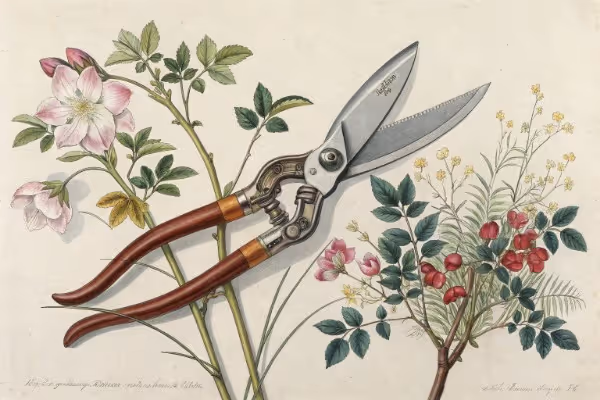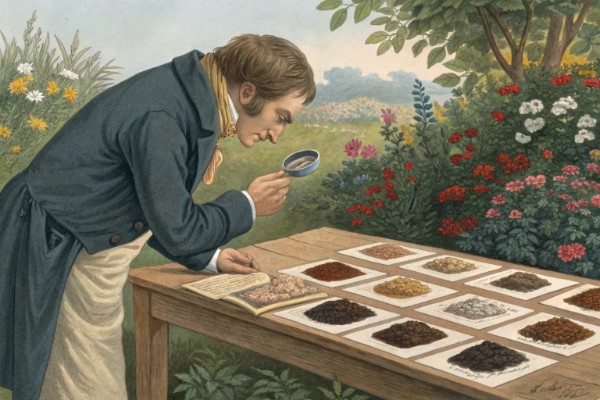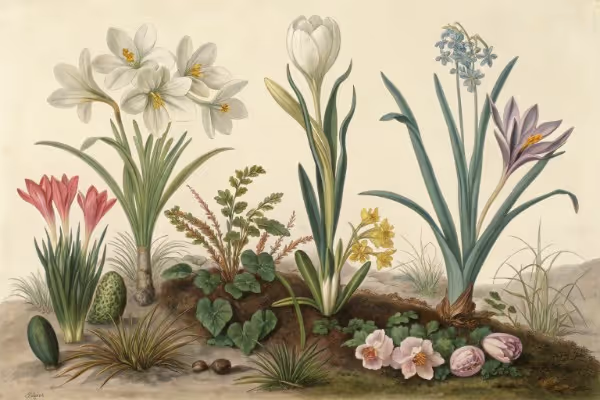Spring Gardening Tips for Healthy Plants and Lovely Landscapes

Spring Gardening
Jumpstart your spring gardening by cleaning and preparing beds early, planting cool-season crops like lettuce and radishes, and pruning shrubs and trees before they leaf out. Check your soil temp; consistent readings above 45°F mean it's spring gardening prime time. Live by these simple actions, and your garden rewards you generously—read on to explore how to maximize every ounce of your spring effort.
Cheatsheet: Spring Prep for Vigorous Gardens
🌱 Soil Wake-up
- Test pH (goal: 6.0–7.0). Amend as needed.
- Add compost or well-rotted manure — 1–2 in (2.5–5 cm).
- Aerate compacted beds with a fork or aerator.
🌷 Prune & Clean
- Trim dead stems, broken branches, ornamental grasses.
- Remove last year’s mulch, spent foliage, leaf litter.
- Sanitize shears between plants: 70% alcohol or bleach solution.
🪴 Smart Planting
- Direct sow cool crops: peas, lettuce, spinach, carrots.
- Transplant hardened seedlings after soil warms: 50°F/10°C+.
- Space for airflow: reduces fungal disease by 70%.
💧 Water Wisely
- Water roots, not leaves — early morning best.
- Install drip irrigation or use a soaker hose to save 30% water.
- Mulch after planting: 2 in (5 cm) to retain moisture, block weeds.
🐞 Pest & Disease Patrol
- Handpick early pests: slugs, beetles.
- Use row covers for seedlings.
- Rotate crops yearly to prevent soil-borne diseases.
🌻 Feed for Growth
- Apply organic fertilizer at planting; follow label rates.
- Topdress perennials with worm castings or compost.
🧤 Tools and Products You'll Need
- Testing kit (pH, soil nutrients)
- Compost, organic fertilizer, mulch
- Pruners, rake, garden fork, gloves
- Drip irrigation kit or soaker hose
- Watering can or hose
- Row covers
🥗 Grow Nutrition & Self-Sufficiency
- Homegrown veggies pack up to 2× more nutrients than store-bought.
- Include herbs: basil, parsley, thyme for easy flavor boosts.
- Plant pollinator flowers for natural pest control & bigger harvests.
- Test and prep soil; amend and aerate as needed.
- Prune, clean beds, sanitize tools.
- Plant seeds/seedlings with proper spacing.
- Water deeply and mulch beds.
- Inspect for pests, rotate crops, set up row covers.
- Fertilize and add compost for sustained growth.
Clear Away Winter's Remains
Winter left its mark—twigs, leaves, and debris littering the beds like forgotten party guests. I grab sturdy gloves, a rake, and waste no time reclaiming territory.
Clearing debris prevents disease and pests; a clean, tidy garden is your best defense. Plants breathe easier, just like we do after a good declutter.
Give the Soil Love: Compost and Mulch Magic
Healthy soil is everything. A friend once asked, "What's your secret to those gorgeous azaleas?" The honest answer: compost, and plenty of it.
I spread rich organic compost, about 1-2 inches (2.5 to 5 cm) thick, across the beds. It provides nutrients, improves soil texture, and boosts microbial activity.
"Good soil is a living universe; compost feeds this invisible community building plant vitality."
After composting, cover with mulch—wood chips, shredded leaves, or straw—roughly 2-3 inches (5 to 7.5 centimeters) deep. Mulch regulates temperature, retains moisture, suppresses weeds, and slowly enriches the soil.
Quick Mulching Tips:
- Avoid piling mulch against trunks or stems to discourage disease.
- Refresh mulch annually to maintain effectiveness.
- Consider locally sourced mulch materials for sustainability and affordability.
Prune with Purpose
I enjoy pruning like cooking: precise cuts, purposeful timing. Spring pruning revitalizes shrubs, trees, and roses, encouraging vigorous growth and flowering.
Use clean, sharp tools consistently. Cut back dead or damaged branches first, then carefully shape the plant, allowing air circulation and promoting sunlight penetration.
Plants to Prune in Early Spring:
- Hybrid roses and ornamental grasses—cutting them back encourages lush growth.
- Fruit trees—prune before buds burst open to ensure the healthiest harvest.
- Hydrangeas—prune old wood cautiously to avoid snipping away future blooms—know your variety first.
Get a Jump on Weeds—Early and Often
Weeds are feisty. They come in quickly and stick around stubbornly. I've learned to act decisively, pulling early and applying an organic pre-emergent herbicide to stop weed seeds from germinating.
Regular visits to weed, even brief 10-minute sessions, outsmart weeds before they spread and multiply.
Planting with Intention—Timing Matters
Wait until soil temperatures hover consistently around 55°F (13°C) before planting annual flowers or summer vegetables. Patience is tough—I once jumped the gun and watched my basil shrivel overnight—but good timing pays dividends in growth, vigor, and productivity.
"Plant too early, you risk frostbite; plant at the right time, you savor abundance."
Spring Favorites for Immediate Beauty:
- Pansies and violas—these cheerful blooms handle a mild chill effortlessly.
- Snapdragons—sturdy stalks, vibrant colors, and resilience against spring turbulence.
- Vegetables—lettuce, peas, carrots, radishes—thrive in cool, early planting conditions.
Check Equipment and Tools
Before fully jumping into spring gardening, I always inspect my tools. Pruners sharpened, mower tuned, hoses checked for leaks—prevention saves frustration later.
Investing a bit of time in early maintenance lets you spend your warm days gardening rather than repairing.
Monitor and Manage Water Wisely
Spring rainfall helps immensely, but supplemental watering is sometimes necessary. Aim for about an inch (2.5 cm) of water weekly, either from rain or supplemental irrigation.
I use drip irrigation or soaker hoses—it saves water and directs moisture straight to the roots, minimizing evaporation.
Invite Beneficial Visitors
Gardens thrive best when filled with beneficial insects and pollinators—bees, butterflies, ladybugs. Planting native species, herbs, and flowers like lavender, echinacea, or dill acts like sending engraved invitations to helpful guests.
I've noticed fewer pest problems and richer harvests ever since encouraging pollinators and beneficial bugs into my space.

Want smarter plant choices? 🪴
Frequently Asked Questions about Spring Gardening
When is the best time to begin planting for spring?
Plant once soil temperatures reach 45°F (7°C), typically between late February and early April, depending on your region. Warm, workable soil encourages effective root growth and robust plant establishment.
How can gardeners effectively prepare garden beds early in spring?
Clear winter debris thoroughly, enrich the soil with a balanced, organic compost to restore nutrients, and loosen compacted soil to improve aeration and drainage. This preparation sets immediate conditions for vigorous spring growth.
What vegetables thrive with early spring planting?
Early-spring vegetables such as peas, spinach, lettuce, carrots, radishes, and kale perform exceptionally well under the cooler temperatures characteristic of early spring. Plant these crops early for an abundant early-season harvest.
What methods help protect plants from unexpected late frost?
Utilizing protective covers such as cloches, row covers, or frost blankets safeguards young plants from unexpected late frost events. Installing these protections during evening hours and removing them after sunrise ensures plants remain healthy without overheating.
How frequently should gardeners water their gardens during spring?
Water garden beds consistently, aiming for about 1 inch (2.5 cm) of water weekly. Consider rainfall frequency to avoid overwatering. Maintaining moist—not waterlogged—soil supports vigorous, healthy plant development.
Should pruning of perennial plants occur in spring?
Early spring provides optimal conditions for pruning perennials. Trim away dead, damaged, or diseased plant matter, stimulating new growth and healthier flowering during subsequent months.
Spring gardening boils down to a few simple things: feed your soil, keep your plants hydrated but not waterlogged, and don’t ignore the weeds. Give your seedlings a boost—cinnamon powder or a handful of eggshells can work wonders. If you’re starting a food garden, remember a little planning saves a lot of sweat later. Sharpen your tools, watch the weather, and don’t be shy about trying something new. The real magic of spring gardening isn’t perfection—it’s paying attention, learning as you go, and getting your hands dirty. Let your yard be a work in progress, and let every season teach you something fresh.
Health Benefits of Spring Gardening: Grow Plants and Well-being
Enhances Mood and Psychological Health
- Soil contact boosts serotonin: Handling soil exposes gardeners to Mycobacterium vaccae, naturally elevating serotonin levels to balance mood and reduce anxiety.
- Cortisol levels reduced: Regular gardening lowers stress hormone cortisol by up to 30%, positively impacting mental clarity and emotional balance.
Improves Physical Strength and Cardiovascular Fitness
- Calorie-burning activity: Moderate-intensity gardening activities, such as weeding or planting, burn 200-400 calories per hour, comparable to brisk walking.
- Strength and flexibility: Digging, pruning, and planting strengthen core muscles, arms, and legs, increasing balance and overall joint flexibility.
Enhances Vitamin D levels and Bone Health
- Sunlight for vitamin D: 15-30 minutes of gardening outdoors daily provides optimal vitamin D, improving calcium absorption and preventing osteoporosis.
- Reduced fracture risk: Regular moderate outdoor activity, like gardening, reduces hip and spinal fractures risk by approximately 30% in adults aged 50 and above.
Supports Immune System Function
- Exposure to beneficial microbes: Hands-on gardening promotes exposure to harmless bacteria, fungi, and other microbes, boosting immune function and decreasing allergy susceptibility.
- Improved respiratory health: Spending time gardening outdoors enhances lung capacity and reduces respiratory ailments from stagnant indoor air.
Fosters Nutritional Self-Sufficiency
- Higher nutrient intake: Home-grown vegetables and herbs contain up to 50% higher nutrient density compared to store-bought produce, improving diet quality.
- Promotes mindful eating: Actively growing food encourages consumption of fresh produce, reducing dependency on processed food and supporting long-term dietary sustainability.
Find out which plants will thrive in your garden!
Answer a few fun questions and get custom plant recommendations perfect for your space. Let’s grow something amazing together!

start your season





